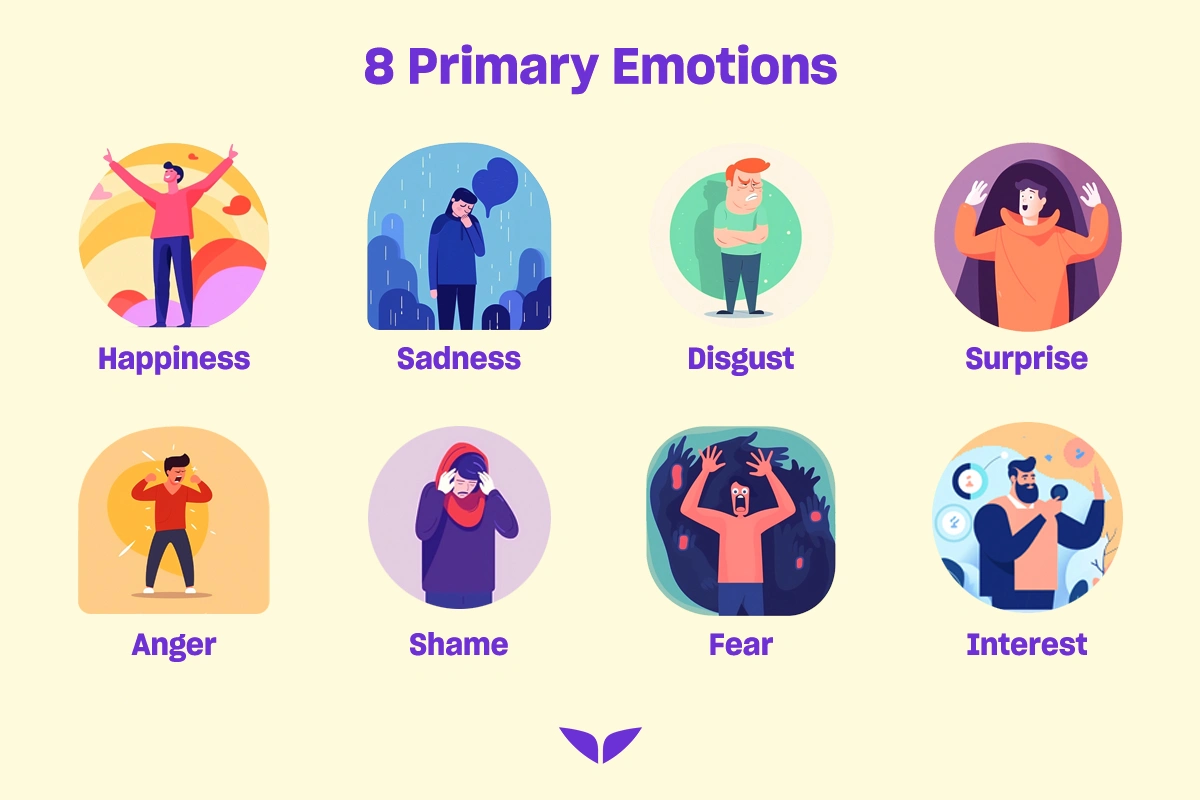Have you ever felt an emotion so strong that your entire body and mind were taken over by it? These are known as primary emotions, and understanding why they arise is essential to having a deeper connection with yourself.
According to Charles Darwin, emotions are what keep us alive. They protect us from danger, prompt us to respond to events around us, and enable us to develop meaningful relationships.
Additionally, there are secondary emotions that are directly connected to one of the primary emotions; these can be pretty complex to understand and deconstruct.
Gaining a deeper understanding of your emotions uncovers the most humane part of you. It opens up the doors to living life wholeheartedly. And here is where you can take the first step.
Types of emotions
Emotions are mainly categorized into two types: primary and secondary.
- Primary emotions are a direct result of experience. They’re powerful and overwhelming but don’t last very long.
- Secondary emotions are more subtle and complex. They’re derived from primary emotions and may often refer to how you feel about an instinctual emotion you experienced.
The ability to feel, understand, and let our emotions guide us is part of what makes us humans who can connect deeply to our inner guidance.
Learn more about how you feel and experience emotions: The Anatomy of Feeling: What Part of the Brain Controls Emotions?
What are primary emotions?
Primary emotions are the emotions that come first, as an instinct or intuition, with no thought processes associated with them.
Experts have developed a variety of theories on emotions, but the most widely accepted one is the Plutchik Model of Emotions, created by psychologist Robert Plutchik. He outlined a primary emotions list that comprises eight different examples:
- Anger
- Fear
- Happiness
- Surprise
- Sadness
- Disgust
- Interest
- Shame
As Jennifer Partridge, EFT therapist and trainer of Mindvalley’s Tapping Into Emotional Mastery Quest, says, “Emotions make us beautifully humans.”

What are secondary emotions?
While our primary emotions are easy to understand, it’s our secondary emotions that are truly complex.
In essence, secondary emotions are a blend of two or more primary emotions. Although not as strong, they tend to last for much longer than primary emotions, and they may have a bigger impact on well-being.
There are many ways that secondary emotions can take form. For example, they might be a result of events from the past. Even though the event that triggered a primary emotion might be far behind you, your emotional memory may trigger similar emotions when similar events happen.
Secondary emotions can also arise from the anticipation of your future. Some examples could include:
- Anxiety
- Amazement
- Boredom
- Rage
- Serenity
- Annoyance
If you’d like to know more, check out this emotions list.
Primary vs. secondary emotions
As mentioned, these two categories of emotions are distinct, and you can understand them better by noticing the differences:
| Primary Emotions | Secondary Emotions |
| Instinctual responses to events | Result from mental processes and potentially past traumas |
| Small range of emotions | Complex variety of emotions |
| Can pass quickly | Last longer |
| Can trigger immediate physiological responses (e.g., screaming, laughing, crying) | More hidden, they often tend to run in the “background” |
Why is it important to understand both primary and secondary emotions?
Studies have shown that humans almost always feel at least one emotion. Everything in your life is deeply emotional, even if you aren’t aware of it. This is why putting some time and effort into understanding your emotions can be a worthy investment.
It can bring you closer to learning how to fill your life with positive energy. And this is most definitely a path worth pursuing. Additionally, you learn step by step how to control your emotions, so they don’t overwhelm you.
There’s something really powerful that happens when you realize that you get to choose how you perceive your experiences.
— Jennifer Partridge, trainer of Mindvalley’s Tapping Into Emotional Mastery Quest
Humans are such emotional beings, there’s no question about it. So being in touch with how and what you’re feeling means being connected to your intuition and the innate wisdom that lies within you.
And it’s important to note the difference between letting yourself feel your emotions with awareness and giving them the power to take control over your behavior.
Tap into the wisdom within
Once you discover how to play with your emotions, you can learn how to take in and process every experience that comes your way, be it positive or negative.
Really lean into the joy and the play. That’s what your soul wants.
— Jennifer Partridge, trainer of Mindvalley’s Tapping Into Emotional Mastery Quest
And if you need a little guidance along the way, Mindvalley is a great place to start. With transformational Quests such as Tapping Into Emotional Mastery with Jennifer Partridge, you can explore:
- How to tap into your emotions and release stuck energy
- The power of letting yourself feel deeply
- How to rewrite deep patterns and make space for new thoughts and behaviors
By claiming your free access today, you can try out sample classes from this program and many others. And when you feel a little stuck on your journey, you can browse through a library full of guided meditations.
Your emotions are a guide to the life you desire to live. And feel.
Welcome in.








